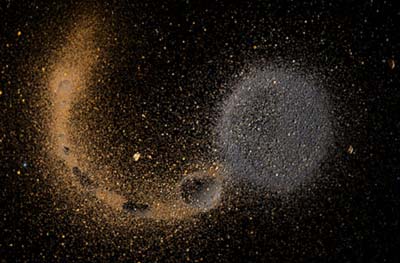Review: Cosmic Collisionsby Craig Remillard
|
| Redford does a terrific job of keeping an understated tone and letting the fantastic imagery speak for itself. He explains scientific concepts clearly and concisely, but does not talk down to the audience. |
However, it is the visual and sound effects that truly steal the show. As the production played, there were numerous spots that elicited oohs, ahhs, and whoas. That the film’s various segments were produced by different teams on different computers is apparent in the different moods of the pieces. A summer meteor shower and a dazzling view of the aurora borealis from low Earth orbit are downright sublime. A bit more theatrical are solar wind particles zipping through Earth’s undulating magnetic field, and the endpiece galactic merger, which shows accurate-as-possible reconstructions of our Milky Way Galaxy and Andromeda do-si-doing around one another, stippled tails of stars whipping outward like spilling milk and brownish gas bands spinning like gyroscopes as the dance coalesces to a tight waltz. The planetarium seats even vibrate and rumble for the most jarring scenes, like a stellar collision in a globular cluster, a reenactment of the K/T impact that ended the reign of the dinosaurs, and the magnum opus, the blinding destruction of the newborn Earth by a Mars-size impactor and the subsequent formation of the Moon.
While the visual quality of the animations was spectacular across the board, the content was somewhat inconsistent. In some cases, the scene was lively and dynamic for several minutes. The creation of the Moon, for instance, enthralled viewers from the first view of the red lava oceans of young Earth, through the sudden and cataclysmic impact, to the steady accretion of Earth and Moon from the resulting rock and dust. Likewise, the galactic merger, which showed several billion years of continuously changing action over several minutes of screen time, left many of us agape until the credits rolled.
Some scenes, however, relied for too long on one nearly static image. The sun’s surface, for instance, hung spinning for a minute or two while Redford explained hydrogen fusion—a piece that would’ve been far more forceful if accompanied by renderings of hydrogen atoms fusing together. Even this simplicity was presented well in most cases, however. The opening meteor shower included few words and very little change in the scene aside from a distant comet, but proved beautiful nonetheless. What exactly classified a “lull” versus a “contemplative pause” may well have varied with the beholder.
Redford’s monologue walks the line between merely retelling what the on-screen images already show and actually offering up some interesting facts. There were many interesting facts, particularly about the K/T impact event’s cataclysmic effects on Earth life, as well as about the Sun and Earth’s magnetic field. On the other hand, many a paragraph had little to do with the on-screen action, and seemed to be included just because it was true. The film would have been better served going into deeper detail about the collisions of stars and research on comets when it showed those heavenly bodies, rather than veering off on unillustrated tangents or rehashing basic information that most people viewing the show already know.
The composers of the narration were clearly scientists with a healthy sense of style (and restraint), rather than pop writers with a crib sheet—few unnecessary phrases were used. Many new theories were mentioned, if not by name then by inclusion of facts. The monologue mentioned the importance of the Moon’s formation to life, a seeming nod to the “Rare Earth” hypothesis of Peter Ward and Donald Brownlee.
| All in all, Cosmic Collisions played like a Discovery Channel documentary on a healthy dose of beta carotene—recent but basic subject matter, and outstanding visuals. |
They may have been a little out of their depth when talking about asteroid diversion, as a lengthy sequence was included about a relatively new idea of using a spacecraft’s gravity to “pull” an asteroid off a collision course with Earth which was introduced in a the November 10, 2005 issue of Nature. When Redford exhorts the crowd that “maybe they could come up with a better way to avoid the fate of the dinosaurs,” I had to wonder if I was the only one in the room thinking, “Just paint the thing white!”
All in all, Cosmic Collisions played like a Discovery Channel documentary on a healthy dose of beta carotene—recent but basic subject matter, and outstanding visuals. While the 20 minute-plus runtime leaves something to be desired, there is much to see in that time and the sequence does not seem rushed. It is certainly a good show for the whole family, with a little something for the mystic, the nerd, and the adrenaline junkie to enjoy in kind.
